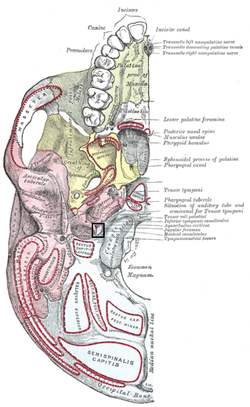Jugular foramen
| Jugular foramen | |
|---|---|
 Base of skull. Inferior surface. (label for jugular foramen is at right, third from the bottom) | |
| Details | |
| Part of | Skull |
| System | Skeletal system |
| Identifiers | |
| Latin | foramen jugulare |
| MeSH | D000080869 |
| TA98 | A02.1.00.054 |
| TA2 | 458 |
| FMA | 56432 |
| Anatomical terminology | |
A jugular foramen is one of the two (left and right) large foramina (openings) in the base of the skull, located behind the carotid canal. It is formed by the temporal bone and the occipital bone. It allows many structures to pass, including the inferior petrosal sinus, three cranial nerves, the sigmoid sinus, and meningeal arteries.
Structure
[edit]The jugular foramen is formed in front by the petrous portion of the temporal bone, and behind by the occipital bone.[1] It is generally slightly larger on the right side than on the left side.
Contents
[edit]The jugular foramen may be subdivided into three compartments, each with their own contents.
- The anterior compartment transmits the inferior petrosal sinus.
- The intermediate compartment transmits the glossopharyngeal nerve, the vagus nerve,[1] and the accessory nerve.
- The posterior compartment transmits the sigmoid sinus (becoming the internal jugular vein),[1] and some meningeal branches from the occipital artery and ascending pharyngeal artery.
An alternative imaging based subclassification exists, delineated by the jugular spine which is a bony ridge partially separating the jugular foramen into two parts:
- The smaller, anteromedial, "pars nervosa" compartment contains CN IX, (tympanic nerve, a branch of CN IX), and receives the venous return from inferior petrosal sinus.
- The larger, posterolateral, "pars vascularis" compartment contains CN X, CN XI, Arnold's nerve (or the auricular branch of CN X involved in the Arnold's reflex, where external auditory meatus stimulation causes cough), jugular bulb, and posterior meningeal branch of ascending pharyngeal artery.
Clinical significance
[edit]Obstruction of the jugular foramen can result in jugular foramen syndrome.[2][3]
Additional images
[edit]-
Jugular foramen
-
Base of the skull. Upper surface.
See also
[edit]References
[edit]![]() This article incorporates text in the public domain from page 181 of the 20th edition of Gray's Anatomy (1918)
This article incorporates text in the public domain from page 181 of the 20th edition of Gray's Anatomy (1918)
- ^ a b c Câmara, Richard; Griessenauer, Christoph J. (2015). "27 - Anatomy of the Vagus Nerve". Nerves and Nerve Injuries. Vol. 1: History, Embryology, Anatomy, Imaging, and Diagnostics. Academic Press. pp. 385–397. doi:10.1016/B978-0-12-410390-0.00028-7. ISBN 978-0-12-410390-0.
- ^ "Parapharyngeal Masses: Their Diagnosis and Management". Archived from the original on 2008-09-07.
- ^ Erol FS, Kaplan M, Kavakli A, Ozveren MF (June 2005). "Jugular foramen syndrome caused by choleastatoma". Clin Neurol Neurosurg. 107 (4): 342–6. doi:10.1016/j.clineuro.2004.08.006. PMID 15885397. S2CID 25145438.
External links
[edit]- Anatomy figure: 22:5b-12 at Human Anatomy Online, SUNY Downstate Medical Center
- Anatomy figure: 22:4a-08 at Human Anatomy Online, SUNY Downstate Medical Center
- cranialnerves at The Anatomy Lesson by Wesley Norman (Georgetown University) (IX, XI)
- "Anatomy diagram: 34257.000-1". Roche Lexicon - illustrated navigator. Elsevier. Archived from the original on 2012-07-22.
- UCSD



